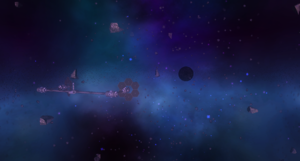
|
This wiki is closed in favour of the new wiki. Information shown is likely to be very out of date. |
Difference between revisions of "Neutron Star (Tau-65)"
m (Xiphos moved page Tau-65 Neutron Star to Neutron Star (Tau-65) without leaving a redirect) |
m (links fixed.) |
||
| Line 1: | Line 1: | ||
| + | {{Version|4.91}} | ||
<div style="font-size:40px; line-height:60px; color:red;">'''WARNING, NAVIGATIONAL HAZARD! '''</div> | <div style="font-size:40px; line-height:60px; color:red;">'''WARNING, NAVIGATIONAL HAZARD! '''</div> | ||
| − | |||
The [[Neutron Star]] found at the East of the [[Tau-65]] system is an X-ray Pulsar, located inside an asteroid belt that is believed to be the remains of a planet that collided with the object. The [[Kawada Research Complex]] was placed at the edge of the asteroid belt, built with large collector dishes that are designed to harness the power of the pulsar's massive radiation bursts. The station's heavy shielding also provides a low radiation zone. | The [[Neutron Star]] found at the East of the [[Tau-65]] system is an X-ray Pulsar, located inside an asteroid belt that is believed to be the remains of a planet that collided with the object. The [[Kawada Research Complex]] was placed at the edge of the asteroid belt, built with large collector dishes that are designed to harness the power of the pulsar's massive radiation bursts. The station's heavy shielding also provides a low radiation zone. | ||
| − | Nicknamed "Ekitei" by the [[Golden Chrysanthemum]] inhabitants, this Neutron Star has a clearing in the area around it, similar to the [[Omega-41 Neutron Star]] and [[Omega-58 Neutron Star]]. However, close proximity to this pulsar is suicidal, as the radiation bursts are so intense even heavily armored ships can be obliterated in seconds. | + | Nicknamed "Ekitei" by the [[Golden Chrysanthemum]] inhabitants, this Neutron Star has a clearing in the area around it, similar to the [[Neutron Star (Omega-41)|Omega-41 Neutron Star]] and [[Neutron Star (Omega-58)|Omega-58 Neutron Star]]. However, close proximity to this pulsar is suicidal, as the radiation bursts are so intense even heavily armored ships can be obliterated in seconds. |
== From the Neural Net: == | == From the Neural Net: == | ||
Revision as of 15:24, 28 November 2018
The Neutron Star found at the East of the Tau-65 system is an X-ray Pulsar, located inside an asteroid belt that is believed to be the remains of a planet that collided with the object. The Kawada Research Complex was placed at the edge of the asteroid belt, built with large collector dishes that are designed to harness the power of the pulsar's massive radiation bursts. The station's heavy shielding also provides a low radiation zone.
Nicknamed "Ekitei" by the Golden Chrysanthemum inhabitants, this Neutron Star has a clearing in the area around it, similar to the Omega-41 Neutron Star and Omega-58 Neutron Star. However, close proximity to this pulsar is suicidal, as the radiation bursts are so intense even heavily armored ships can be obliterated in seconds.
From the Neural Net:
The X-ray Pulsar is officially classfied as X-384 by scientists and interstellar navigation organisations, but most Golden Chrysanthemums simply refer to it by the name Ekitei. Ekitei releases periodic bursts of X-ray radiation, which can last from a fraction of a second up to several minutes between bursts. The pulses also tend to be directional, and any unshielded life forms would instantly die if exposed to an x-ray burst.
